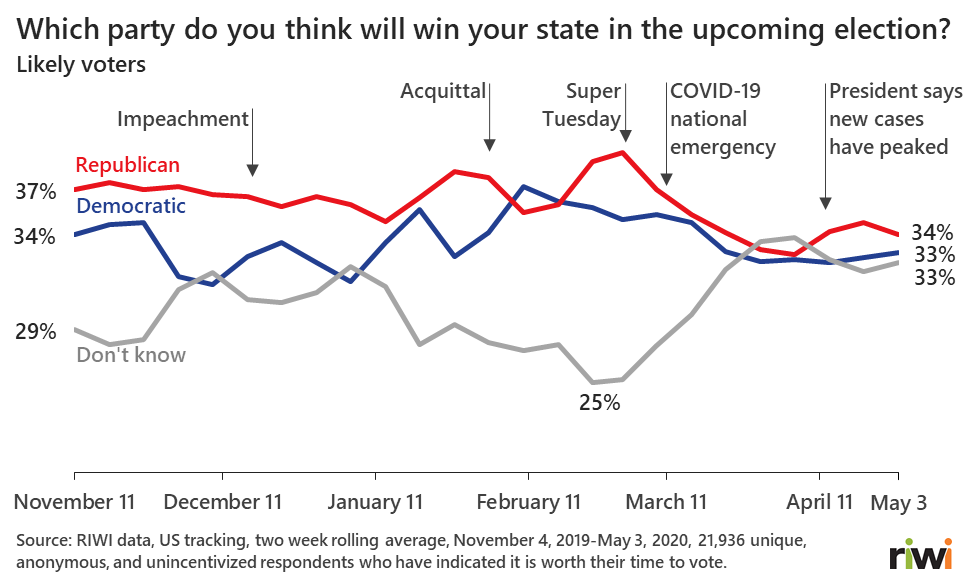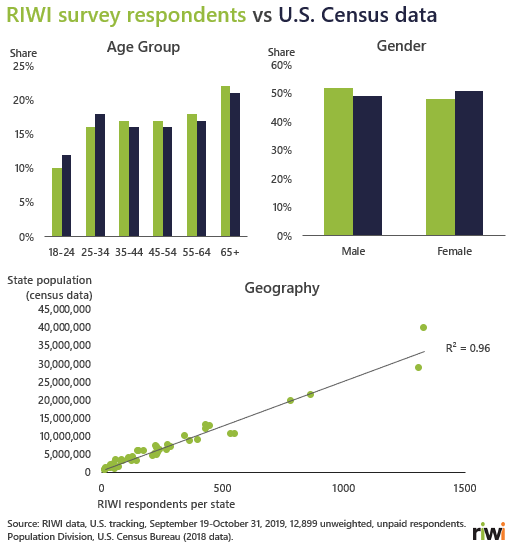By: Emily Kuzan
High-frequency and ongoing sentiment shows a dramatic increase in uncertainty in the election result
Since COVID-19 hit, RIWI crowd predictors have become much more uncertain about election results. Those predictors who are certain now predict a Republican win, in contrast to traditional polls. RIWI asked “who will win the election” rather than about personal preference because academic research and previous RIWI predictions show that asking respondents to predict the outcome leads to more accurate predictions.
Among RIWI likely voter respondents, the share of don’t know responses surged nearly ten percentage points from March 2 to April 6. This could be a response to both the COVID-19 epidemic and the winnowing of the field of Democratic presidential candidates. While the increase leveled off through April, the share of respondents who think it is worth their time to vote continues to rise. It will be crucial to monitor whether the views of these undecided crowd predictors solidify leading up to the election.
Most traditional polls indicate that President Trump is dropping in the polls. By contrast, RIWI data show crowd predictions for President Trump rose among likely voters through April from 33 percent to 35 percent, landing at 34 percent at the beginning of May. In the crucial Midwest region, predictions for a Republican win grew, reversing the drop seen in RIWI’s March data.
Former Vice President Biden ahead of President Trump in a head-to-head matchup
President Trump and Former Vice President Biden have been neck and neck in our matchup since fall 2019. This month we see the presumptive Democratic nominee secure his largest, albeit still very narrow, lead over President Trump yet, among all respondents (see chart below). Vice President Biden holds this lead among likely voters as well, of which 37 percent prefer Vice President Biden, 35 percent President Trump, and 28 percent don’t know. The gap between those that think President Trump will win in their state versus those that personally prefer him to win could point to a recurrence of the “shy Trump voter” effect, which contributed to traditional polls underestimating his support in 2016. Studies show that people are less likely to voice their support for a controversial candidate.

About RIWI’s 2020 U.S. Election Monitor
Two of the “X-factors” that caused conventional polls to miss the 2016 election and that could manifest again in 2020 were:
1) the underreflection of typically disengaged populations including those in the Midwest and
2) the “shy Trump voter” effect. 1
In this ongoing monthly series, RIWI uses a methodology that addresses these factors. The data are collected using a method that continuously randomly exposes questions so that anyone online in the US has an equal chance of exposure. This approach resulted in over half or more of RIWI’s US respondents not having answered a survey in the past month. It also resulted in data that are representative of the US population before weighting to census demographics. RIWI’s unweighted US election data nearly match U.S. census data when comparing age, gender, and geographic distribution. This allows us to access the views of typically disengaged populations that were missed in 2016. RIWI also asks for crowd predictions rather than personal views, and collects all data anonymously, in order to reduce the “shy Trump voter” effect.

About RIWI
RIWI stands for “real-time interactive world-wide intelligence”. We provide access to continuous consumer and citizen sentiment in all countries. RIWI breaks through the noise to find the truth about what people really think, want and observe – by reaching the most diverse audiences, including the disengaged and quiet voices who do not typically answer surveys or express their views on social media. RIWI technology rapidly collects data in every country around the world and displays the results in a secure interactive dashboard in real-time. We only collect anonymous information: 229 countries and territories, over 80 languages and 1.6 billion interviewees and counting.
Related Research:
U.S. 2016 Election: Predicting Electoral College for President-Elect Trump and the Popular Vote for Clinton
Could a fear-demic lead to an unnecessarily severe economic crisis?
COVID-19’s Income Truth: Real-time losses are worse than they appear
- Russonello, G. (2019, November 23). Four Problems With 2016 Trump Polling That Could Play Out Again in 2020. The New York Times. Retrieved from https://www.nytimes.com/2019/11/23/us/politics/2020-trump-presidential-polls.html